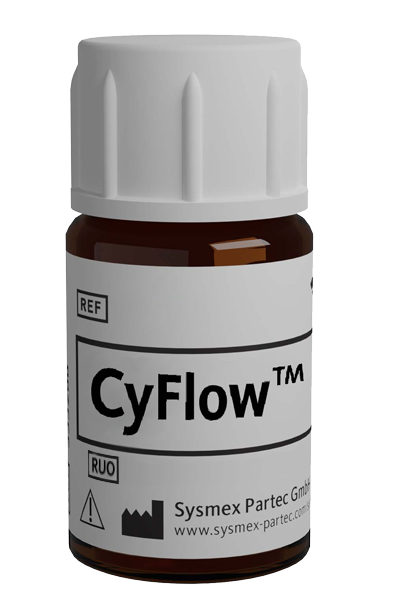CyFlow™ CD135 PE

| Alternative Name: | Flk2, Flt3 , STK1 |
| Antibody: | Yes |
| Antigen: | CD135 |
| Application: | Flow cytometry |
| Clonality: | monoclonal |
| Clone: | BV10A4 |
| Emission Maximum: | 576 nm |
| Excitation Maximum: | 496 nm, 565 nm |
| Field of Interest: | Immunophenotyping, Phosphorylation |
| Format/Fluorochrome: | PE |
| Isotype: | IgG1 |
| Laser: | Blue , Green, Yellow |
| Regulatory Status: | RUO |
| Source Species: | Mouse |
| Target Species: | Human |
| Product number: | BJ941654 |
For Research Use Only
| Quantity | 100 tests |
| Volume | 2.0 mL |
| Immunogen | BV-173 leukemic cell line |
| Background Information | CD135 (FLT3, FLK2, STK-1) is a receptor tyrosine kinase that plays important roles in hematopoiesis. After binding of FLT3 ligand (FL), CD135 homodimerizes and stimulates proliferation, differentiation and protects the cell from apoptosis. The loss of CD90 and gain of CD135 expression marks the loss of self-renewal in hematopoietic stem cell population. Detectable CD135 expression appears first at low levels on the surface of primitive multilineage progenitor cells and disappears during defined stages of B-cell development but is upregulated and maintained during maturation of monocytes. CD135 is also expressed on thymocytes, dendritic cell progenitors and on mature dendritic cells, as well as on various malignant hematopoietic cells. |
| Usage | The reagent is designed for Flow Cytometry analysis of human blood cells. Recommended usage is 20·µl reagent·/ 100·µl of whole blood or 10^6 cells in a suspension. The content of a vial (2 ml) is sufficient for 100 tests. |
| Storage Buffer | The reagent is provided in stabilizing phosphate buffered saline (PBS) solution, pH ≈7.4, containing 0.09% (w/v) sodium azide. |
| Storage | Avoid prolonged exposure to light. Store in the dark at 2-8°C. Do not freeze. |
| Stability | Do not use after expiration date stamped on vial label. |
| Kishimoto T, Goyert S, Kikutani H, Mason D, Miyasaka M, Moretta L, Ohno T, Okumura K, Shaw S, Springer TA, Sugamura K, Sugawara H, von dem Borne AEGK, Zola H (Eds): Leucocyte Typing VI. Garland Publishing Inc, New York. 1997; 1‑1342. < NLM ID: 9712219 > | Rappold I, Ziegler BL, Köhler I, Marchetto S, Rosnet O, Birnbaum D, Simmons PJ, Zannettino AC, Hill B, Neu S, Knapp W, Alitalo R, Alitalo K, Ullrich A, Kanz L, Bühring HJ: Functional and phenotypic characterization of cord blood and bone marrow subsets expressing FLT3 (CD135) receptor tyrosine kinase. Blood. 1997 Jul 1; 90(1):111‑25. < PMID: 9207445 > | Haylock DN, Horsfall MJ, Dowse TL, Ramshaw HS, Niutta S, Protopsaltis S, Peng L, Burrell C, Rappold I, Buhring HJ, Simmons PJ: Increased recruitment of hematopoietic progenitor cells underlies the ex vivo expansion potential of FLT3 ligand. Blood. 1997 Sep 15; 90(6):2260‑72. < PMID: 9310477 > | Christensen JL, Weissman IL: Flk‑2 is a marker in hematopoietic stem cell differentiation: a simple method to isolate long‑term stem cells: a simple method to isolate long‑term stem cells. Proc Natl Acad Sci USA. 2001 Dec 4; 98(25):14541‑6. < PMID: 11724967 > | Whartenby KA, Calabresi PA, McCadden E, Nguyen B, Kardian D, Wang T, Mosse C, Pardoll DM, Small D: Inhibition of FLT3 signaling targets DCs to ameliorate autoimmune disease. Proc Natl Acad Sci USA. 2005 Nov 15; 102(46):16741‑6. < PMID: 16272221 > | Kuchenbauer F, Kern W, Schoch C, Kohlmann A, Hiddemann W, Haferlach T, Schnittger S: Detailed analysis of FLT3 expression levels in acute myeloid leukemia. Haematologica. 2005 Dec; 90(12):1617‑25. < PMID: 16330434 >
